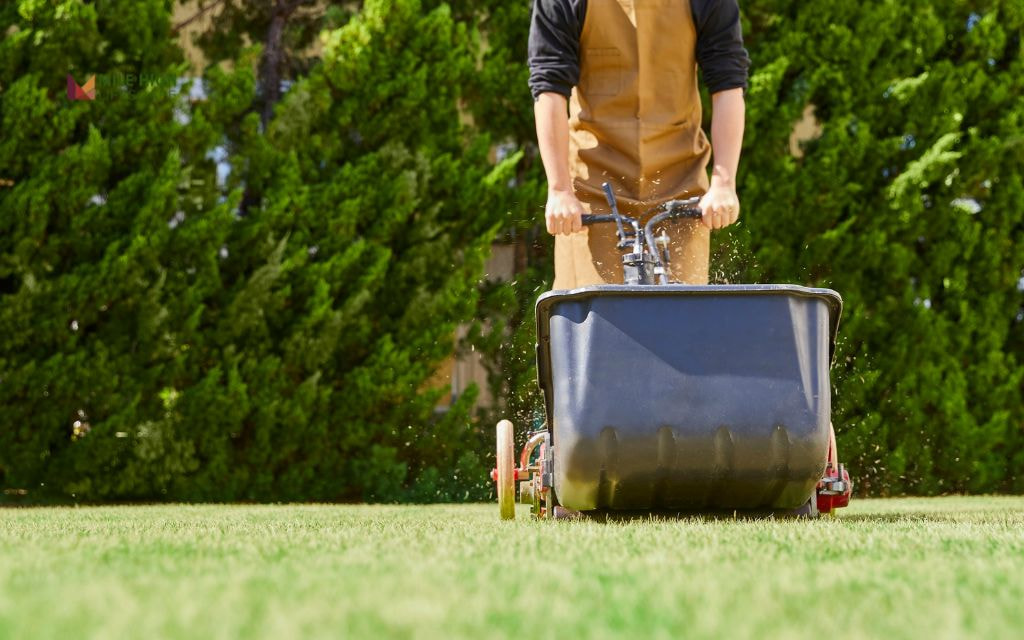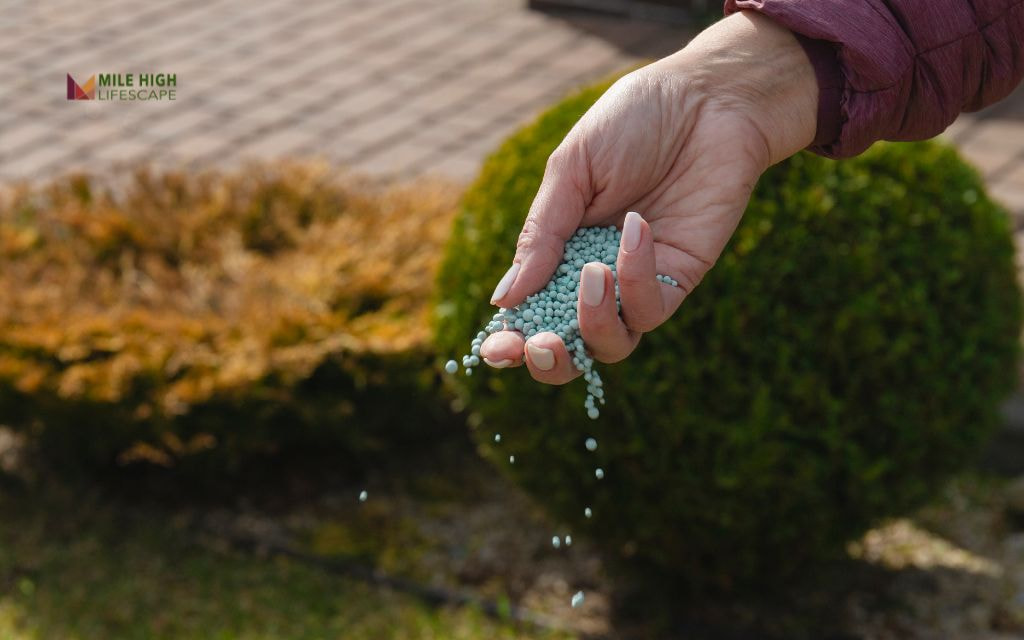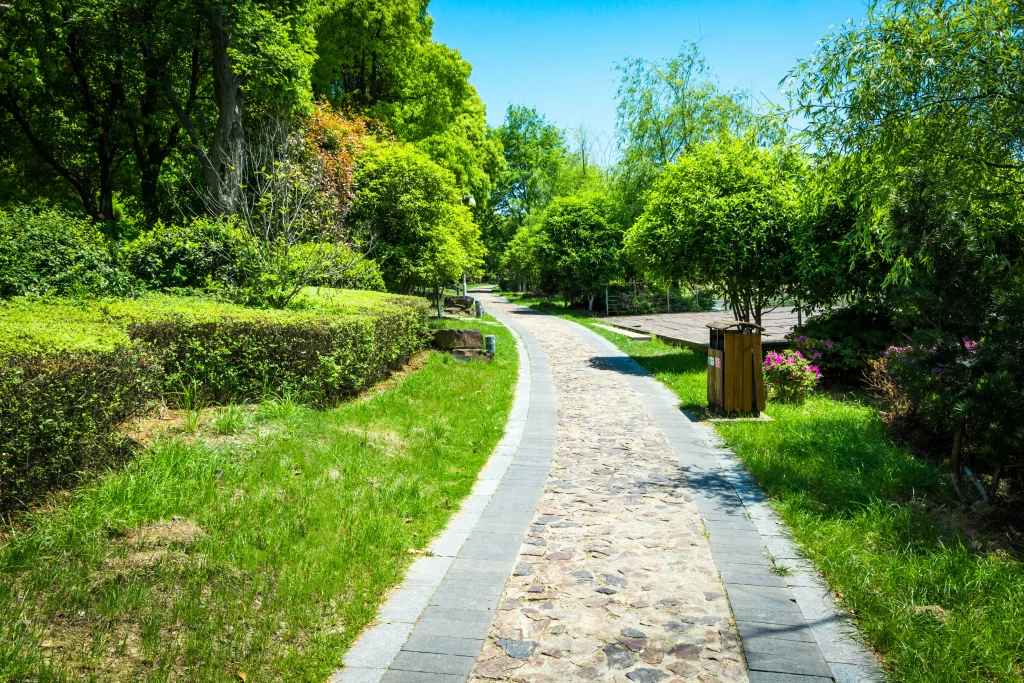Does your lawn turn brown every winter? Denver’s climate presents specific challenges for maintaining healthy grass. The combination of cold temperatures, dry air, early frosts, and compacted soil creates harsh conditions for your lawn to endure.
Fall fertilization offers a solution by helping grass roots grow deeper, store essential nutrients, and survive Colorado’s snow and freezing temperatures.
With the right approach, your lawn can emerge greener and healthier in spring. In this guide, you’ll discover which products work best for Denver lawns, when to apply them, and how to maximize your results.
What Makes a Great Fall Lawn Fertilizer for Denver
The Right Nutrient Balance
For Denver lawns, focus on an NPK ratio with moderate nitrogen to support root health without excessive top growth.
Choose fertilizers with higher potassium content to enhance cold resistance – critical for surviving Colorado winters. Unless you’ve recently installed new sod or overseeded, your lawn needs minimal phosphorus.
Denver-Specific Considerations
Our region’s alkaline soil benefits from fertilizers containing iron or sulfur to correct pH imbalances. These ingredients improve nutrient availability and prevent yellowing common in Denver’s high-pH soils. Look for products with 20-5-15 or 24-0-10 NPK ratios for best results in our climate.
Slow-Release vs. Quick-Release
Prioritize slow-release fertilizers for fall application. These products supply nutrients gradually over several weeks – ideal before winter snowfall.
Quick-release options risk stimulating vulnerable top growth right before freezing temperatures arrive. Choose granular forms with water-insoluble nitrogen for the most consistent results during fall conditions.
Best Fall Lawn Fertilizers in Denver: Product Guide
Slow-Release Granular Fertilizers
Slow-release granular fertilizers excel in providing consistent nutrient delivery during cooler months. These products release nutrients gradually as soil microbes break down the granules, which matches the reduced uptake rate of grass during fall.
Products with high potassium content strengthens cell walls in grass plants, improving resistance to cold stress and disease. These granular options cover large areas efficiently and maintain effectiveness through early winter snowfall.
Liquid Fertilizers
Liquid fertilizers offer rapid absorption – a benefit for spot treatment, small lawns, or situations requiring quick nutrient delivery. However, they prove less ideal for promoting deep root growth unless paired with aeration.
For Denver lawns, apply liquid fertilizers earlier in fall (September to early October) to ensure complete nutrient utilization before winter dormancy. Products formulated specifically for cool-season grasses provide the best results in our region’s climate.
Organic Fertilizers
Organic options can enhance soil health while providing necessary nutrients. These pet-safe formulations enrich your lawn’s ecosystem over time by supporting beneficial microorganisms.
The primary consideration with organic fertilizers involves timing – they break down more slowly than synthetic alternatives, especially in cool temperatures. Apply these products in early fall to ensure adequate decomposition and nutrient release before winter.
When to Apply Fall Fertilizer in Denver
Timing significantly impacts fertilizer effectiveness. The ideal window for Denver lawns falls between late September and early October when soil temperatures remain warm enough for active root growth but top growth begins to slow.
This period allows grass roots to absorb nutrients and store energy before winter dormancy. The grass redirects energy from blade growth to root development during this time, making it perfect for supporting your lawn’s foundation.

For lawns showing stress, thinning areas, or recent overseeding, consider a second light application in late October. However, avoid fertilizing after the ground freezes, as this wastes product and potentially creates spring runoff issues.
Coordinate fertilization with other fall lawn tasks. Applying fertilizer after aeration maximizes nutrient penetration into the root zone. Similarly, fertilizing shortly after overseeding supports new grass establishment before winter.
Adjusting Fall Lawn Fertilizer Plans by Grass Type
Most Denver lawns feature cool-season grasses like Kentucky bluegrass and tall fescue. These varieties respond exceptionally well to fall fertilization, using this period to strengthen their root systems before winter dormancy.
Kentucky Bluegrass Needs
This popular Denver grass requires consistent nitrogen to maintain density. Its shallow root system benefits significantly from fall feeding to improve drought and cold tolerance. Look for fertilizers with at least 20% nitrogen for bluegrass lawns.
Fescue Varieties
Tall fescue, with its deeper root system, responds well to fertilizers with higher potassium levels. For mixed lawns containing both bluegrass and fescue, select balanced formulations that support both grass types. Fescue typically needs less frequent fertilization than bluegrass.
Problem Area Solutions
Lawns with poor soil conditions need special attention. Areas with clay soil benefit from incorporating organic matter alongside fertilization to improve drainage and nutrient availability. For thin or damaged lawns, pair fertilization with overseeding for comprehensive restoration.
Shaded areas under trees face unique challenges, competing with tree roots for nutrients while receiving less sunlight. These sections need precise fertilizer application, focusing on nitrogen utilization in low-light conditions.

Why Fall Fertilizer Is Crucial for Denver Lawns
Root Season Focus
Fall marks the time when grass shifts energy from blade growth to root development. During autumn, your lawn naturally prioritizes strengthening its foundation. Fertilizing now supports this critical root-building phase, creating stronger grass that withstands winter stress.
Energy Storage for Winter
Fall fertilization helps grass manufacture and store carbohydrates. These energy reserves enable your lawn to survive Denver’s freeze-thaw cycles and support spring green-up without depleting the plant’s resources. Think of it as packing your lawn’s winter survival kit.
Denver’s Unique Challenges
Our region presents specific conditions that make fall feeding essential. High elevation means intense sun exposure and quick soil drying. Many properties have thin topsoil with low organic matter, resulting in poor nutrient retention. Fall fertilization counters these challenges by building resilience before winter arrives.
Long-Term Benefits
A proper fall feeding program delivers advantages beyond winter. Lawns receiving autumn nutrition typically green up faster in spring, develop deeper roots for better drought resistance, and naturally crowd out weeds through increased density. This investment pays dividends in reduced maintenance needs throughout the following year.
How to Apply Fall Lawn Fertilizer Like a Pro
Follow these steps for professional-quality results:
- Mow your lawn to 2.5-3 inches, providing optimal surface area for fertilizer contact while maintaining adequate leaf tissue for photosynthesis.
- Remove leaves and debris through raking or blowing to ensure fertilizer reaches the soil rather than becoming trapped in surface materials.
- Consider aerating compacted soil before application, creating pathways for fertilizer to reach root zones effectively.
- Load your spreader according to the manufacturer’s instructions, adjusting settings based on the specific product you’ve selected.
- Apply fertilizer on dry grass, preferably in morning or evening hours when wind remains minimal and foot traffic won’t disrupt distribution.
- Water lightly after application (about 1/4 to 1/2 inch) to activate the fertilizer and move nutrients into the soil profile.
- Clean equipment thoroughly to prevent corrosion and store remaining product in a cool, dry location for future use.
Remember: Avoid over-fertilizing in fall. Excessive application creates greater risks than underapplication in cold climates, potentially causing nutrient runoff and stimulating vulnerable growth before freezing temperatures.

Common Fall Fertilizing Mistakes to Avoid
Even experienced lawn enthusiasts make these errors when fertilizing in fall:
- Using spring/summer fertilizer formulations for fall application introduces the wrong type of nitrogen, potentially stimulating excessive top growth at the expense of root development. These products typically lack the higher potassium levels necessary for winter hardiness.
- Failing to check soil moisture before application prevents proper nutrient absorption. Fertilizer applied to excessively dry soil often remains inert until sufficient moisture becomes available – sometimes delaying effectiveness until spring.
- Applying fertilizer after snow or hard frost wastes resources since dormant grass cannot effectively utilize nutrients. The product likely washes away during spring thaw rather than benefiting your lawn.
- Neglecting leaf cleanup before fertilization creates barriers between nutrients and soil. Leaves prevent even distribution and absorb fertilizer that should reach your grass roots.
- Fertilizing completely dormant turf provides minimal benefits since the grass lacks the biological activity necessary to process and store nutrients during full dormancy.
Need Help? Call Mile High Lifescape Now
At Mile High Lifescape, we’ve served the Denver Metro area for nearly two decades with specialized lawn care services.
Our approach includes custom-blended fertilizers formulated specifically for Denver’s unique growing conditions. We begin with comprehensive soil testing to identify existing nutrient levels and imbalances before creating tailored treatment plans.
Our fall services extend beyond basic fertilization to include core aeration, overseeding, and soil amendment packages that address multiple lawn needs simultaneously. Our technicians understand Denver’s microclimate variations and adjust applications accordingly.
Contact us today at (303) 877-9091 or visit our website.
Conclusion
Remember that timing matters – apply your selected fall lawn fertilizer before the first hard frost to maximize effectiveness. For optimal results, pair fertilization with aeration and address any existing lawn issues before winter sets in.
Don’t delay this crucial lawn care task. The investment you make this fall will pay dividends when your lawn greens up faster and stronger than your neighbors’ in spring.
Request a free fall lawn assessment from Mile High Lifescape today to create a customized fertilization plan for your property.
Frequently Asked Questions (FAQs)
What is the best fertilizer for grass in the fall?
A complete fertilizer with high nitrogen and potassium ratios supports enhanced rooting, cold hardiness, and disease resistance. For Denver lawns, look for N:P ratios around 24-4-12 with slow-release nitrogen compounds like IBDU for extended nutrient availability.
What is the best month to fertilize your lawn in Denver?
Apply fall fertilizer between late September and early October in Denver. This timing aligns with the grass’s transition from top growth to root development and allows nutrients to be absorbed before cold temperatures limit biological activity.
Should fall fertilizer be watered in?
Most fall fertilizers require light watering after application to activate the product and move nutrients into the soil profile. Apply approximately 1/4 to 1/2 inch of water, enough to dissolve granules without causing runoff. Follow specific instructions on your selected product for best results.
Is organic fertilizer strong enough for fall in Denver?
Organic fertilizers work effectively for fall application in Denver when applied early enough in the season. These products improve long-term soil health while providing necessary nutrients, but they break down more slowly in cool temperatures. Apply organic options in early fall to ensure complete nutrient release.
How late is too late to fertilize in Denver?
Avoid fertilizing after mid-November in lower Denver elevations and after late October in higher-elevation areas like Colorado Springs. Once the ground freezes consistently, grass enters dormancy and cannot efficiently utilize applied nutrients. Fertilizer applied too late wastes resources and potentially contributes to spring runoff issues.
